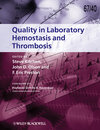
„There are particularly useful chapters covering the monitoring ofheparin and oral anticoagulation. The book is pretty up to date andeven covers the monitoring of new anticoagulants.“ (The Bulletinof the Royal College of Pathologists, July 2010)
Quality in Laboratory Hemostasis and Thrombosis
Vorwort von Frits R. Rosendaal, herausgegeben von Steve Kitchen, John D. Olson und F. Eric Preston„Over the last decades, major progress has been made in qualityassurance of hemostatic laboratory assays. This book will be anindispensable part of every hemostasis laboratory, where, given itshands-on nature, it will rarely sit to get dusty on theshelves.“
--Frits R. Rosendaal, Leiden University MedicalCenter
The hemostasis laboratory has a vital role in the diagnosis andmanagement of patients with familial and acquired hemorrhagic andthrombotic disorders. Its role in the monitoring traditionalanticoagulant therapy as well as therapy using new anticoagulantspresents new challenges to the laboratory. Quality in LaboratoryHemostasis and Thrombosis not only addresses these importantissues, but also covers international guidelines for testing, thedevelopment of international standard materials, management ofhemostasis testing from the laboratory to the point of care as wellas molecular genetic testing.
Designed as a guide for all those working in hemostasislaboratories, this book details a quality program that, when putinto place, will help to improve standards in testing. All of theauthors are internationally recognised for their work in hemostasisand thrombosis. Using their experience, they provide information onstandards, equipment and methods that will guide the development ofa quality program to support all activities in the hemostasislaboratory.






